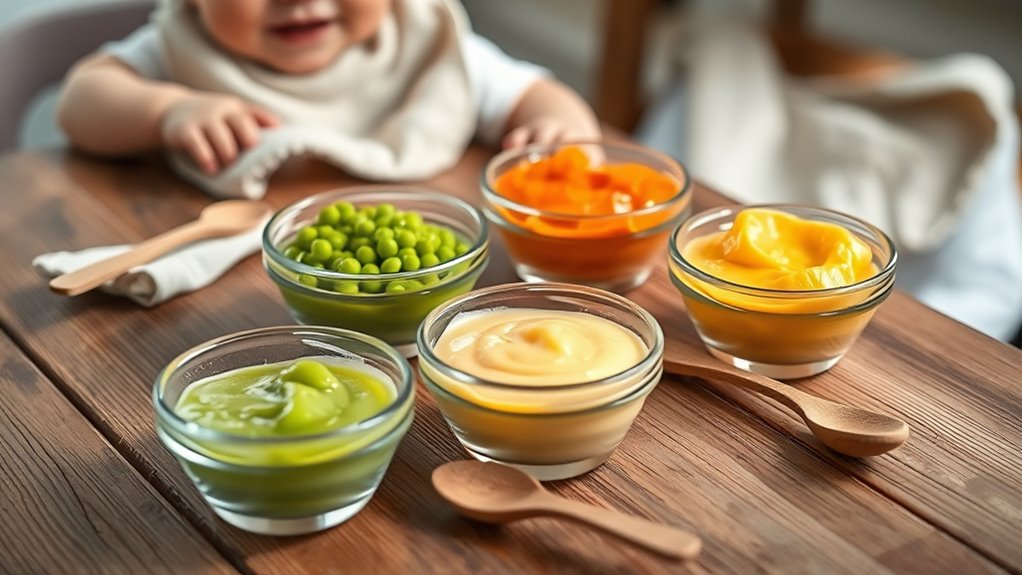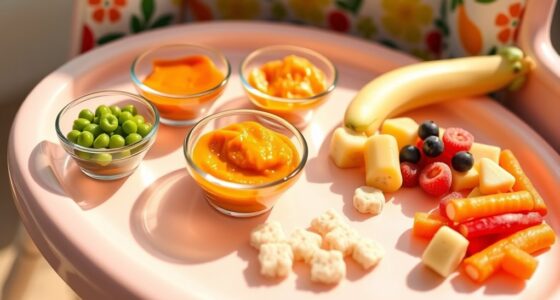To make simple, wholesome baby food for ages 6–9 months, start with easy purees like mashed apples or pears, and colorful veggie purees such as carrots or sweet potatoes. Add protein-rich options like cooked lentils or beans, and gradually introduce mild spices for flavor. Focus on smooth textures initially and progress to small soft chunks as your baby develops chewing skills. If you keep exploring, you’ll discover more tips for safe storage and flavor combinations.
Key Takeaways
- Introduce a variety of colorful fruit and vegetable purees like apple, pear, carrots, and sweet potatoes to develop baby’s palate.
- Incorporate protein sources such as lentils, beans, or tofu to support growth and muscle development.
- Gradually add mild spices and texture variations to expand flavor profiles and promote oral skills.
- Use safe preparation methods like steaming and blending, and store purees in labeled, airtight containers for freshness.
- Progress from smooth purees to small soft chunks and finger foods to encourage chewing and self-feeding skills.
Easy Fruit Purees for Baby’s First Tastes

Introducing your baby to solid foods is an exciting milestone, and starting with easy fruit purees makes the process smooth and enjoyable. When it comes to meal presentation, keep the purees vibrant and appealing by serving them in small, colorful bowls or on a baby-friendly spoon. This encourages curiosity and makes feeding time more engaging. Establishing a consistent feeding schedule helps your baby adjust to new tastes and routines, making mealtime predictable and less stressful. Offer small spoonfuls of pureed fruit, like apple or pear, and wait for your baby to finish before offering more. This approach fosters good eating habits and helps you monitor their preferences and reactions. Remember, patience and consistency are key as your little one explores these delicious first flavors. For a well-rounded approach, consider incorporating best baby food practices to support your child’s developmental eating skills. Additionally, understanding how dreaming and sleep patterns influence your child’s mood can help create a calm mealtime environment. Recognizing the importance of feeding schedules can also enhance your baby’s acceptance of new foods and routines. Incorporating knowledge about nutrition guidelines can further ensure your baby receives balanced and adequate nourishment.
Nutritious Vegetable Purees to Explore
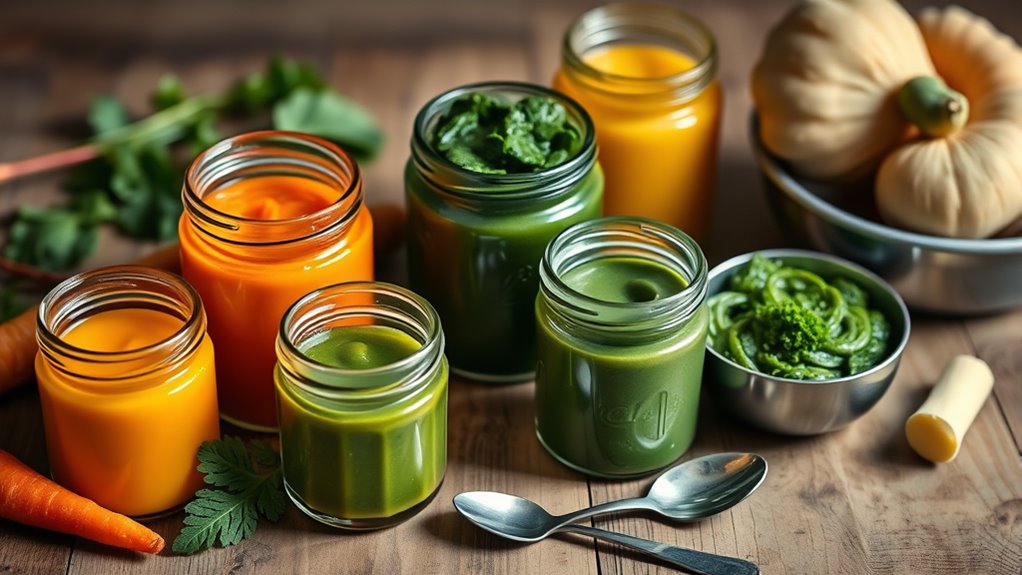
Exploring nutritious vegetable purees is a great way to diversify your baby’s diet and boost their intake of essential vitamins and minerals. When preparing these purees, focus on vibrant colors and smooth textures to make meal presentation appealing. Using baby feeding tools like small spoons and silicone bowls helps make feeding easier and more enjoyable. Incorporate vegetables like carrots, peas, and sweet potatoes for variety. Here’s a quick overview:
| Vegetable | Benefits | Preparation Tips |
|---|---|---|
| Carrots | Rich in beta-carotene | Steam until tender, then mash |
| Peas | High in fiber and protein | Puree until smooth, strain if needed |
| Sweet Potatoes | Loaded with vitamin A | Roast or boil, then blend smoothly |
Creating a variety of purees also allows you to explore different color accuracy and textures, enriching your baby’s sensory experience. Understanding nutritional benefits can help you select the most suitable vegetables for your child’s development. Including a wide range of vegetables can also support immune health and overall growth. Additionally, being aware of Gold IRA regulations can inform your long-term investment planning, much like choosing the right vegetables for your baby’s health.
Protein-Packed Purees for Growth
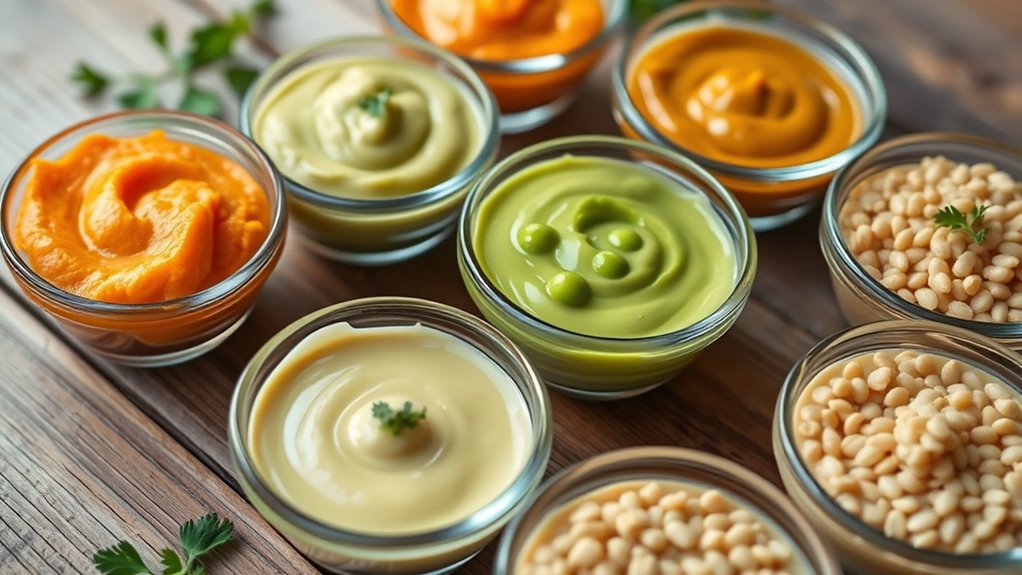
Adding protein to your baby’s purees helps support their growth and development. You can use sources like beans, lentils, or dairy to boost their intake. Combining these with veggies creates tasty, nutritious purees that promote healthy growth. For added assurance of quality, opt for ingredients sourced from reputable suppliers with transparency in sourcing.
Protein Sources for Babies
Protein is essential for your baby’s growth and development, especially during the pureed stage when they’re just beginning to explore new textures. You have a variety of protein sources to include in their diet, ensuring they get enough nutrients. While traditional options like meats and eggs are common, plant-based proteins are excellent for variety and nutrition. Quinoa alternatives and other plant-based proteins can be easily incorporated into purees, offering fiber and essential amino acids. These options are also suitable for families following vegetarian or vegan diets. Including a mix of proteins helps support muscle development and overall health. Incorporating protein diversity into your baby’s diet can help ensure they receive a broad spectrum of essential nutrients necessary for their growth.
- Lentils and split peas
- Tofu and tempeh
- Cooked and pureed beans
- Quinoa alternatives like amaranth
- Nut butters (thinly spread)
Combining Protein With Veggies
Incorporating vegetables with protein sources creates nutrient-dense purees that support your baby’s growth. Combining options like cooked lentils, beans, or meat alternatives with pureed carrots, peas, or sweet potatoes offers a balanced mix of vitamins, minerals, and protein. Dairy options such as yogurt or cottage cheese can add creaminess and extra protein, making the puree more appealing and nutritious. These combinations help your baby develop strong muscles and a healthy immune system. You can experiment with pureed chicken or turkey blended with spinach or squash for variety. Always ensure ingredients are cooked thoroughly and pureed smooth to avoid choking hazards. Mixing veggies with protein sources provides a well-rounded, flavorful puree that promotes growth and introduces your little one to diverse textures.
Combining Flavors for New Palates
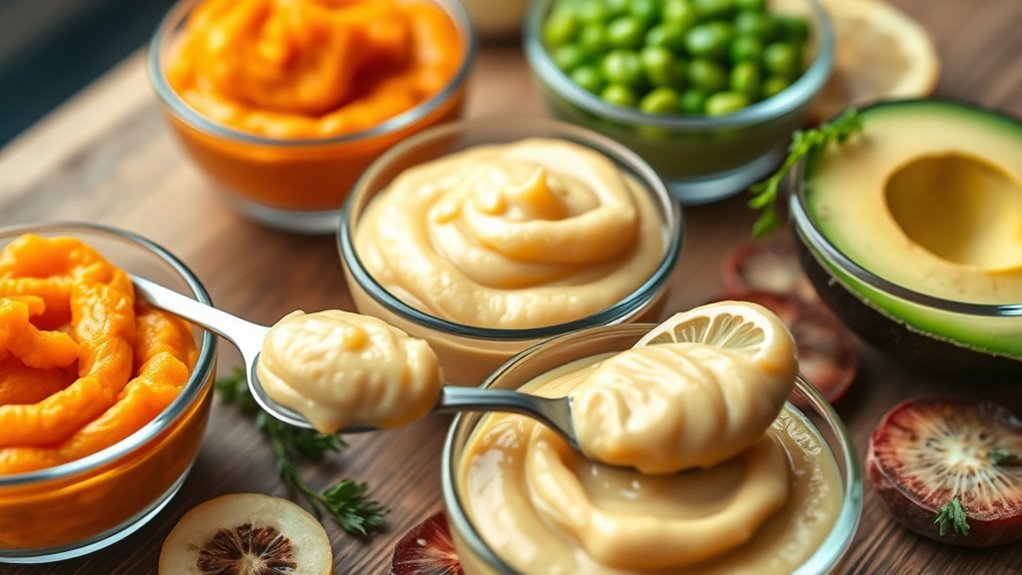
Mixing fruits and veggies creates exciting new flavors your baby will enjoy discovering. Introduce spices gradually to expand their palate without overwhelming them. Smoothly blending different textures helps your little one comfortably experience these tasty combinations.
Mixing Fruits and Veggies
Have you ever wondered how combining different fruits and vegetables can create exciting new flavors for your little one? Mixing seasonal combinations not only introduces variety but also helps your baby explore different tastes and textures. Using color contrast, like bright orange carrots with green peas, makes the puree visually appealing. You can experiment with simple pairings to find what your baby enjoys most.
- Sweet potato and apple
- Carrot and pear
- Peas and banana
- Butternut squash and peach
- Zucchini and mango
These combinations provide a mix of flavors and nutrients, making mealtime fun and nutritious. Stick to familiar ingredients and gradually introduce new pairings to help your baby develop a palate for diverse tastes.
Introducing Spices Gradually
Introducing spices gradually can transform your baby’s meals by adding new flavors without overwhelming their palate. Start with simple spice combinations like cinnamon with apple or mild turmeric with sweet potato. These gentle flavors support healthy flavor development and help your baby become accustomed to different tastes. When introducing spices, use small amounts to avoid overpowering the natural sweetness of the purees. Observe how your baby responds to each new spice, and if they seem receptive, gradually increase the variety over time. Incorporating spices thoughtfully encourages acceptance of diverse flavors and builds a foundation for a well-rounded palate. Remember, patience is key—every new spice offers a chance to expand your baby’s taste experiences safely.
Blending Textures Smoothly
To help your baby develop a smooth shift to new flavors, blending textures seamlessly is essential. You’ll want to focus on texture variation to keep meals interesting while ensuring safety. Start with a smooth puree, then gradually incorporate small pieces for practice with chewing. When needed, use consistency adjustments like adding breast milk, formula, or water to achieve a thinner, more manageable texture. As your baby adapts, introduce slightly chunkier textures to promote oral development. Always pay attention to your baby’s cues, adjusting the blend accordingly.
- Use a food processor or blender for smooth purees
- Add liquids gradually for consistency adjustments
- Mix in soft, cooked fruits or vegetables for texture variation
- Incorporate small, cooked grains or proteins gradually
- Test the texture to match your baby’s evolving chewing skills
Texture Tips for Transitioning Foods

Changing your baby to new textures can feel like a delicate process, but focusing on gradual changes helps build their confidence and chewing skills. Start by introducing subtle textural contrasts, such as mixing smooth purees with small, soft chunks. This helps your baby get used to different sensations without overwhelming them. Incorporating variety in textures can keep your baby engaged and curious about new foods. As they become more comfortable, incorporate finger foods like soft cooked vegetables or small pieces of fruit. These allow your baby to explore different textures independently, promoting self-feeding and coordination. Remember to observe your baby’s cues and progress at their pace. Patience is key—don’t rush the transition. Offering a variety of textures and encouraging self-feeding can also help developmental milestones, and understanding family dynamics can enhance your approach. Supporting your baby with these gentle steps fosters their overall growth and confidence. By providing a range of textures and fostering self-feeding, you help your little one develop essential oral motor skills in a safe, supportive way. Additionally, practicing mindfulness during feeding can create a calm environment that supports emotional well-being.
Tips for Preparing and Storing Baby Food

Properly preparing and storing baby food guarantees it stays fresh, safe, and nutritious. To assure food safety, always wash your hands and use clean utensils. Use appropriate storage containers—preferably BPA-free and airtight—to prevent contamination and spoilage. When preparing purees, portion out servings to avoid repeated thawing and refreezing, which can degrade nutrients. Label containers with dates so you can track freshness. Store purees in the refrigerator for up to 48 hours or freeze for up to three months. Thaw frozen food in the fridge or warm water, avoiding microwaves to prevent uneven heating. Keep all storage areas clean and organized to maintain the integrity of your baby’s food. Incorporating food safety practices can further reduce the risk of contamination and ensure your baby’s meals remain healthy. Additionally, choosing appropriate storage containers that are designed to preserve nutrients can help maintain the quality of homemade baby food. Being aware of proper storage durations is also essential for keeping food safe and nutritious over time. Regularly monitoring air quality in your storage area can help prevent spoilage and maintain food freshness.
Frequently Asked Questions
How Do I Know if My Baby Is Ready for New Purees?
You’ll know your baby is ready for new purees when you see signs of readiness, like good head control and sitting up with support. Look for developmental milestones such as showing interest in your food or opening their mouth when offered solids. If your baby can move food to their back of the mouth and swallow easily, it’s a good sign they’re prepared for new textures and flavors.
Can I Introduce Allergenic Foods at This Stage?
Like opening Pandora’s box, introducing allergenic foods can feel risky, but it’s often necessary. At this stage, you can start feeding allergenic foods, including nuts and eggs, with caution. Introducing spices can also help your baby develop new tastes. Always watch for reactions, and consult your pediatrician if you have concerns. Gradually, you’ll help your little one build a diverse, safe palate for their future.
What Are Safe Storage Durations for Homemade Baby Food?
When it comes to storage guidelines for homemade baby food, you want to guarantee refrigeration safety. Typically, you should store purees in airtight containers and consume them within 24 to 48 hours. If you need to keep them longer, freezing is a good option—most purees stay safe for up to 3 months. Always label your containers and reheat thoroughly before serving to keep your baby safe.
How Can I Ensure My Baby Gets Enough Iron?
To guarantee your baby gets enough iron, include iron-rich foods like pureed meats or fortified cereals in their diet. If you’re vegetarian, add plant-based options such as pureed beans, lentils, or spinach, which provide non-heme iron. Pair these with vitamin C-rich foods like pureed fruits to boost iron absorption. Regularly offering these foods helps support your baby’s healthy growth and development.
Are There Any Foods to Avoid During This Stage?
Did you know that about 8% of children have food allergies by age 3? During this stage, you should avoid foods that pose choking hazards, like whole nuts or grapes, and steer clear of potential allergens such as honey, shellfish, and peanuts. These can cause food allergies or choking. Always introduce new foods one at a time and watch for any signs of allergic reactions, ensuring your baby stays safe.
Conclusion
As you guide your little one through these gentle culinary adventures, remember that each new taste is a quiet step toward their blossoming curiosity. Embrace the small moments of discovery, knowing you’re creating a warm foundation for their future favorites. With patience and love, you’re helping them explore the world one gentle bite at a time. Enjoy this special journey—each tiny spoonful is a sweet chapter in their growing story.

